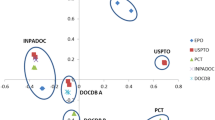Abstract
The objective of this research is to develop a new patent bibliometric performance measure by using modified citation rate analyses with dynamic backward citation windows. Cited half-life employed in bibliometrics was adopted in order to establish a model of annual patent backward citation windows. Based on the dynamic behavior of backward citation windows, the annual backward patent citation rates for each technology domain can be calculated to measure its bibliometric performance. It was found that the dynamic backward citation window represents more accurately the citation cycle time which is a key factor on technology assessment. Because different technology domain may have disparate attributes, a normalized backward citation rate was developed to measure the corresponding rank for each domain respect to the entire industry. Three technology domains were then chosen for demonstrative case studies which represent semiconductor, LCD, and drug industries.







Similar content being viewed by others
References
Allan, A. (2001). Business cycle market/demand forecasts vs. TSCR cycle model. International SEMATECH. Presentation at the global economic workshop, Monterey, California, USA.
Amin, M., & Mabe, M. A. (2003). Impact factors: Use and abuse. MEDICINA (Buenos Aires), 63, 347–354.
Andrew, P. K. (2003). Understanding the limitations of the journal impact factor. The Journal of Bone & Joint Surgery, 2449–2454.
Asai, I. (1981). Adjusted age distribution and its application to impact factor and immediacy index. Journal of the American Society for Information Science, 32, 172–174.
Berton, R. E., & Kebler, R. W. (1960). The “half-life” of some scientific and technical literatures. American Documentation, 11, 18–22.
Breitzman, A. F., & Narin, F. (2001). Method and apparatus for choosing a stock portfolio, based on patent indicators. United States Patent, 6175824.
CHI Research Inc. (2001). Tech-line: Technology indicators. Retrieved June 6, 2001, from http://www.chiresearch.com/techline/indicator.htm.
Dong, P., Loh, M., & Mondry, A. (2005). The “impact factor” revisited. Biomedical Digital Libraries, 2(7), 8.
Garfield, E. (1972). Citation analysis as a tool in journal evaluation. Science, 178, 471–479.
Gay, C., & Le Bas, C. (2005). Uses without too many abuses of patent citations or the simple economics of patent citations as a measure of value and flows of knowledge. Economics of Innovation and New Technology, 14, 333–338.
Griffith, B. C. (1988). Derek Price’s puzzles: Numerical metaphors for the operation of science. Science, Technology, and & Human Values, 13(3/4), 351–360.
Ladwig, J. P., & Sommese, A. J. (2005). Using cited half-life to adjust download statistics. College and Research Libraries, 527–542.
Lichtenberg, F., & Virabhak, S. (2002). Using patents data to map technical change in health-related areas. OECD Science, Technology and Industry Working Papers, 48 p.
Narin, F. (1993). Technology indicators and corporate strategy. Review of Business, 14(3), 19–23.
Narin, F., & Hamilton, K. S. (1996). Bibliometric performance measure. Scientometrics, 36(3), 293–310.
Pudovkin, A. I., & Garfield, E. (2004). Rank-normalized impact factor: A way to compare journal performance across subject categories. In American Society for Information Science and Technology Annual Meeting. November 17, 2004. Providence Rhode Island.
Ramirez, A. M., Garcia, E. O., & Del Rio, J. A. (2000). Renormalized impact factors. Scientometrics, 47(1), 3–9.
Sombatsompop, N., & Markpin, T. (2005). Making an equality of ISI impact factors for different subject fields. Journal of the American Society for Information Science and Technology, 56(7), 676–683.
Sombatsompop, N., Markpin, T., & Permkamolnetr, N. (2004). A modified method for calculating the impact factors of journals in ISI journal citation reports: Polymer science category in 1997–2001. Scientometrics, 60(2), 217–235.
Stolpe, M. (2002). Determinants of knowledge diffusion as evidenced in patent data: The case of liquid crystal display technology. Research Policy, 31, 1181–1198.
Van Leeuwen, T. N., & Moed, H. F. (2002). Development and application of journal impact factor measures in the Dutch science system. Scientometrics, 53(2), 249–266.
Weinstein, R., & Huang, S. (1999). Valuing patents and intangible assets in the semiconductor industry. The Licensing Journal, 19(2), 8–13.
Author information
Authors and Affiliations
Corresponding author
Rights and permissions
About this article
Cite this article
Chen, DZ., Lin, CP., Huang, MH. et al. Constructing a new patent bibliometric performance measure by using modified citation rate analyses with dynamic backward citation windows. Scientometrics 82, 149–163 (2010). https://doi.org/10.1007/s11192-009-0044-8
Received:
Accepted:
Published:
Issue Date:
DOI: https://doi.org/10.1007/s11192-009-0044-8



